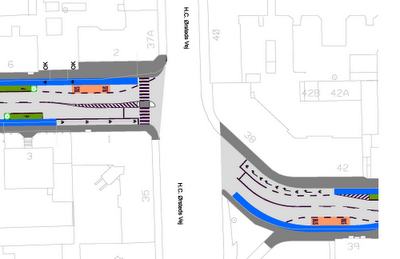
 I live in a city called Frederiksberg, which is an independent enclave surrounded by Copenhagen. There’s about 90,000 citizens in the city. The city has a well-developed bicycle infrastructure. You can’t really not have it when you’re surrounded by Copenhagen.There are few streets left in the city that don’t have separated bike lanes/cycle tracks/whatever you want to call them. One of the stretches is Thorvaldsensvej and the bike lane was finished just last week. It’s pictured, above. Previously on this stretch there was a painted lane where there is now a physically separated lane.With that said, it’s certainly not every street that has separated bike lanes. The residential streets around our flat certainly don’t. There isn’t enough traffic to merit separation. It’s only on streets that feature a certain numbers of cars each day. Normally, according to the Danish best practice guidelines for bicycle infrastructure a cycle track is implemented - replacing a painted bike lane - when the number of cars is over 6000 a day and the speed limit is 50 km/h. [If the speed limit is 30 km/h, 10,000 cars a day is the limit before separated cycle tracks are built]. What we’re seeing, however, in many parts of Greater Copenhagen is that separated cycle tracks are being built even when the number of cars per day is lower.
I live in a city called Frederiksberg, which is an independent enclave surrounded by Copenhagen. There’s about 90,000 citizens in the city. The city has a well-developed bicycle infrastructure. You can’t really not have it when you’re surrounded by Copenhagen.There are few streets left in the city that don’t have separated bike lanes/cycle tracks/whatever you want to call them. One of the stretches is Thorvaldsensvej and the bike lane was finished just last week. It’s pictured, above. Previously on this stretch there was a painted lane where there is now a physically separated lane.With that said, it’s certainly not every street that has separated bike lanes. The residential streets around our flat certainly don’t. There isn’t enough traffic to merit separation. It’s only on streets that feature a certain numbers of cars each day. Normally, according to the Danish best practice guidelines for bicycle infrastructure a cycle track is implemented - replacing a painted bike lane - when the number of cars is over 6000 a day and the speed limit is 50 km/h. [If the speed limit is 30 km/h, 10,000 cars a day is the limit before separated cycle tracks are built]. What we’re seeing, however, in many parts of Greater Copenhagen is that separated cycle tracks are being built even when the number of cars per day is lower.
"It should be safe and secure to ride bicycles in Copenhagen. That's why we're building cycle tracks in Stormgade. If 50% of Copenhageners use the bicycle to get to work or school in 2015 we'll save 80,000 tonnes C02 each year."
At time of writing this there are 338 km of cycle tracks, 19 km of cycle lanes and 39 km of green cycling routes. More are on the way. Add to that all the shared space streets and residential streets that do not require infrastructure.We're filling in the blanks.






